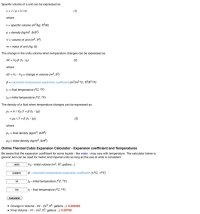I agree with your comments regarding the oil expansion issue noted above.
To highlight this and add some meat to the bones of your comment,
see chart below stating the Volumetric thermal expansion coefficients for some common liquids are indicated below.
Engine oil is stated, we will assume that most engine oil is within a very similar parameter as other brands and viscosity etc.
if the engine oil in an were at 18 degrees when the engine was not running (at ambient outside temp) the oil on the Dip stick should read somewhere between halfway within the cross hatch section and toward the lower end of the cross hatch Marked on the dipstick !
the oil will naturally expand when running at normal operating temps, let’s assume this is around 110 degrees C, the oil will of course expand somewhat:
but to no where near the extent that the expansion should affect oil sensors as suggested by the OP on face book!
assuming a sump volume of 7.5 litres of engine oil (sound familiar)
1000 litres = 1m3, so the 7.5 litres of oil in your sum is equivalent to 0.0075m3.
below is an illustration of 7.5 litres of engine oil (I.e. 0.0075m3) showing the expansion of the engine oil, that would take place, when the engine was at its upper running temp (110 degrees C i.e it had been working fairly hard)
The illustration shows the engine oil would expand by a maximum of 0.00048m3 or 480ml. or Approximately 6.5% by volume
(Assuming the temperature parameters are not exceeded this is the maximum effect on a full oil capacity whilst the engine is being used under fairly heavy strain)
for the reason stated above, (Expansion during use) is it recommended, that engine oil should be checked when the engine is at operating temp.
obviously this illustration does not take account of the distribution of oil throughout the engine block and power train system whilst the vehicle is running, which will naturally reduce the volume of oil in the sum, whilst the vehicle is running.
most of the oil will return to the sump a short time after the engine is turned off, which will become visually measurable on the dip stick.
It does not explain or give rationale why, during normal use, the coefficient of expansion could affect the oil to such an extent, whilst driving, that an “overfill“ warning would light up. (Unless the engine was severely overfilled in the first place? which I doubt would be the case for many?
I agree with your comments regarding the oil expansion issue noted above.
To highlight this and add some meat to the bones of your comment,
see chart below stating the Volumetric thermal expansion coefficients for some common liquids are indicated below.
Engine oil is stated, we will assume that most engine oil is within a very similar parameter as other brands and viscosity etc.
if the engine oil in an were at 18 degrees when the engine was not running (at ambient outside temp) the oil on the Dip stick should read somewhere between halfway within the cross hatch section and toward the lower end of the cross hatch Marked on the dipstick !
the oil will naturally expand when running at normal operating temps, let’s assume this is around 110 degrees C, the oil will of course expand somewhat:
but to no where near the extent that the expansion should affect oil sensors as suggested by the OP on face book!
assuming a sump volume of 7.5 litres of engine oil (sound familiar)
1000 litres = 1m3, so the 7.5 litres of oil in your sum is equivalent to 0.0075m3.
below is an illustration of 7.5 litres of engine oil (I.e. 0.0075m3) showing the expansion of the engine oil, that would take place, when the engine was at its upper running temp (110 degrees C i.e it had been working fairly hard)
The illustration shows the engine oil would expand by a maximum of 0.00048m3 or 480ml. or Approximately 6.5% by volume
(Assuming the temperature parameters are not exceeded this is the maximum effect on a full oil capacity whilst the engine is being used under fairly heavy strain)
for the reason stated above, (Expansion during use) is it recommended, that engine oil should be checked when the engine is at operating temp.
obviously this illustration does not take account of the distribution of oil throughout the engine block and power train system whilst the vehicle is running, which will naturally reduce the volume of oil in the sump, whilst the vehicle is running.
most of the oil will return to the sump a short time after the engine is turned off, which will become visually measurable on the dip stick.
the software update will help fix the issue, but oil level on a warm engine should be half way up the dipstick not to the top.
View attachment 176919
View attachment 176923



